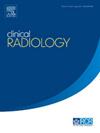计算机断层扫描中最大注射压力与造影剂外渗率的关系
IF 1.9
3区 医学
Q2 RADIOLOGY, NUCLEAR MEDICINE & MEDICAL IMAGING
引用次数: 0
摘要
目的本研究的目的是通过多变量分析来阐明成人造影剂外渗率与最大注射压力之间的关系。材料和方法我们招募了2688例接受对比增强计算机断层扫描的患者。静脉导管由负责检查的护士或医生置于肘正中静脉。我们获得了以下信息:年龄、性别、体重指数、留置针直径、注射速度、造影剂浓度、分数剂量、最大注射压力、有无外渗、住院/门诊状态。结果住院/门诊患者的优势比和最大注射压力的优势比为2.62 (P <;0.05)和1.64 (P <;分别为0.001)。采用截断值9.5 kg/cm2,最大注射压力曲线下面积为0.68。结论建议在肘正中静脉置管时,最大注射压力阈值应设定为9.5 kg/cm2,以有效减少造影剂外渗。本文章由计算机程序翻译,如有差异,请以英文原文为准。
Relationship between maximum injection pressure and extravasation rate of contrast media in computed tomography
AIM
The purpose of this study was to use multivariate analysis to clarify the relationships between the extravasation rates of contrast media and maximum injection pressure in adults.
MATERIALS AND METHODS
We recruited 2688 patients who underwent contrast-enhanced computed tomography. The intravenous lines were placed in the median cubital vein by the nurse or physician in charge of the examination. We obtained the following information: age, sex, body mass index, indwelling needle diameter, injection speed, contrast media concentration, fractional dose, maximum injection pressure, presence or absence of extravasation, and in/out-patient status.
RESULTS
The odds ratios of in/out-patients and maximum injection pressures were 2.62 (P < 0.05) and 1.64 (P < 0.001), respectively. Using a cut-off value of 9.5 kg/cm2, the area under the curve of the maximum injection pressure was 0.68.
CONCLUSION
We recommend that a threshold of 9.5 kg/cm2 be set for the maximum injection pressure when placing an intravenous line in the median cubital vein to efficiently reduce extravasation of the contrast media.
求助全文
通过发布文献求助,成功后即可免费获取论文全文。
去求助
来源期刊

Clinical radiology
医学-核医学
CiteScore
4.70
自引率
3.80%
发文量
528
审稿时长
76 days
期刊介绍:
Clinical Radiology is published by Elsevier on behalf of The Royal College of Radiologists. Clinical Radiology is an International Journal bringing you original research, editorials and review articles on all aspects of diagnostic imaging, including:
• Computed tomography
• Magnetic resonance imaging
• Ultrasonography
• Digital radiology
• Interventional radiology
• Radiography
• Nuclear medicine
Papers on radiological protection, quality assurance, audit in radiology and matters relating to radiological training and education are also included. In addition, each issue contains correspondence, book reviews and notices of forthcoming events.
 求助内容:
求助内容: 应助结果提醒方式:
应助结果提醒方式:


